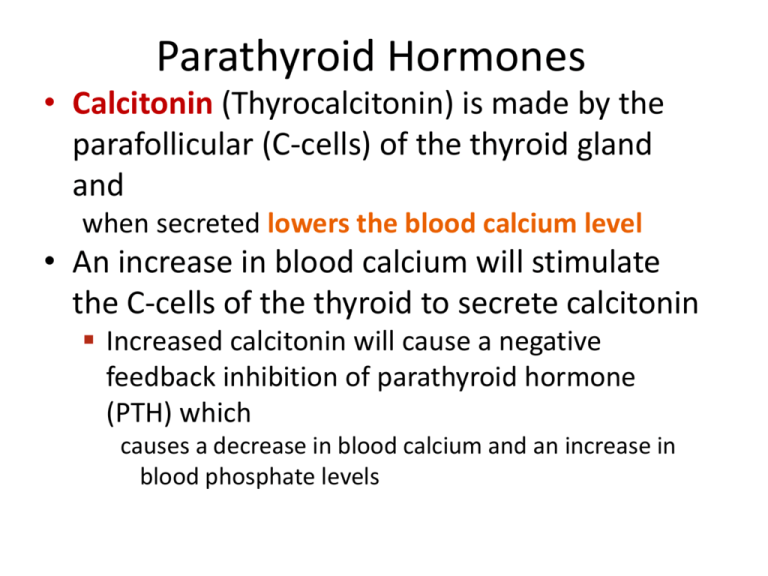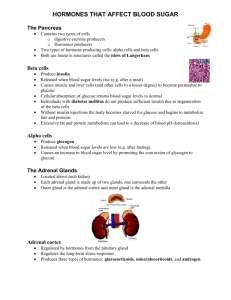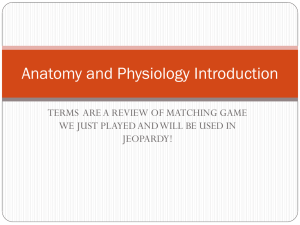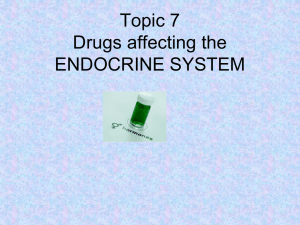
Parathyroid Hormones
• Calcitonin (Thyrocalcitonin) is made by the
parafollicular (C-cells) of the thyroid gland
and
when secreted lowers the blood calcium level
• An increase in blood calcium will stimulate
the C-cells of the thyroid to secrete calcitonin
Increased calcitonin will cause a negative
feedback inhibition of parathyroid hormone
(PTH) which
causes a decrease in blood calcium and an increase in
blood phosphate levels
PARATHYROID HORMONES
(Interactions Animation)
• Calcitonin
You must be connected to the internet to run this animation
Parathyroid Hormones
• Parathyroid hormone (PTH) is made by the
more numerous chief (principal) cells of the
gland
PTH increases absorption
of Ca2+ from the GI tract
and stimulates osteoclastic
activity so that Ca2+ is
released from bone into
the blood
PARATHYROID HORMONES
(Interactions Animation)
• Parathyroid Hormone
You must be connected to the internet to run this animation
Calcium Regulation
1 High level of Ca2+ in blood
stimulates thyroid gland
parafollicular cells to
release more CT.
3 Low level of Ca2+ in blood
stimulates parathyroid
gland chief cells to release
more PTH.
6 CALCITRIOL stimulates
increased absorption of
Ca2+ from foods, which
increases blood Ca2+ level.
5 PTH also stimulates
the kidneys to release
CALCITRIOL.
4 PARATHYROID HORMONE (PTH)
promotes release of Ca2+ from
bone extracellular matrix into
blood and slows loss of Ca2+
in urine, thus increasing blood
Ca2+ level.
2 CALCITONIN inhibits
osteoclasts, thus decreasing
blood Ca2+ level.
The Adrenal Glands
• There are two adrenal glands, one superior to
each kidney (also called the suprarenal
glands). During embryonic development, the
adrenal glands differentiate into two
hormones
structurally and functionallySteroid
distinct
regions
like cortisol
• the adrenal cortex
• the adrenal medulla
Catecholamines like
norepinephrine
The Adrenal Glands
The Adrenal Cortex
• The adrenal cortex is peripherally located and
makes up 80-90% of the total weight of the
gland
The cortex is subdivided into three zones, each of
which secretes a different group of steroid
hormones, all formed
from the cholesterol
molecule
Adrenocortical Hormones
• Just deep to the CT capsule, the cells of the
zona glomerulosa synthesize
mineralocorticoid hormones
• The middle zone, or zona fasciculata, secrete
mainly glucocorticoid hormones,
primarily cortisol
• The inner zona reticularis
is the site of synthesis
of weak androgens
(masculinizing hormones)
Adrenocortical Hormones
• Mineralocorticoids regulate the concentrations of Na+
and K+ in the blood (affects blood volume/pressure)
Aldosterone is the major hormone in this group
• Glucocorticoids influence glucose metabolism and the
ability to resists the effects of stress
Cortisol is the major hormone in this group
• Weak androgens (masculinizing sex hormones) have
little effect in men, but play an important role in
promoting libido in women
RAAS
• The most important effects of aldosterone is
seen in the renin-angiotensin-aldosterone
system (RAAS)
The RAAS is stimulated by a decrease in blood
volume and/or blood pressure – as in cases of
dehydration or hemorrhage. Low BP stimulates
juxtaglomerular cells
in the kidney to
secrete the
enzyme renin
RAAS
Renin converts the plasma protein angiotensinogen
(produced in the liver) into angiotensin I. As
angiotensin I circulates to the lungs, an enzyme called
angiotensin converting enzyme (ACE) converts
angiotensin I to angiotensin II
– Angiotensin II stimulates the adrenal cortex to secrete
aldosterone (salt and H20 resorption indirectly increases
BP), and it is a
potent vasoconstrictor (which
directly increases BP)
RAAS
Glucocorticoids
• Glucocorticoids (mainly cortisol) regulate
metabolism by promoting the breakdown of
proteins and fats to form glucose
(gluconeogenesis). Increased blood sugar levels
assist the body to cope with stress
Their inflammatory effects result from inhibiting
white blood cells. Unfortunately they also retard
tissue repair and slow wound healing
• glucocorticoids are very useful in the treatment of chronic
inflammatory disorders such as Lupus, though long term
side-effects are severe
Glucocorticoids
• High levels of circulating cortisol, as seen
with corticosteroid drugs (prednisone), or
tumors (adrenal cortex, pituitary gland) is
called Cushing’s syndrome
Manifestations include hyperglycemia, poor wound healing,
osteoporosis, dermatitis, fat
redistribution (spindly arms and
legs, moon face, buffalo hump at
the neck), and truncal obesity
Glucocorticoids
In adults, hyposecretion of glucocorticoids
and aldosterone, usually as a result of an
autoimmune disorder, is called Addison’s
disease
– The physiologic effects include
hypoglycemia, Na+ loss, low BP,
dehydration, and muscle weakness
• only after his death did the world
learn that President Kennedy
suffered from Addison’s disease
The Adrenal Medulla
• The inner region of the adrenal gland, the
adrenal medulla, is a modified sympathetic
ganglion that develops from the same
embryonic tissue as all other sympathetic
ganglia of the ANS and is innervated by
sympathetic preganglionic neurons
The catecholamines epinephrine (80%), and
norepinephrine (20%), are secreted at the
adrenal medulla and serve to prolong the
sympathetic response
ADRENAL MEDULLA HORMONES
(Interactions Animation)
• Epinephrine/Norepinephrine
You must be connected to the internet to run this animation
The Pancreas
• The pancreas is both an endocrine and an
exocrine gland. It is located posterior and
inferior to the stomach. We will discuss its
endocrine functions here and its exocrine
functions
in detail in chapter 24
The Pancreas
• Most of the exocrine cells of the pancreas
are arranged in clusters called acini and
produce digestive enzymes which flow
through ducts into the GI tract
Distributed among the acini are clusters of
endocrine tissue
called pancreatic
islets (islets of
Langerhans)
Pancreatic Hormones
• Each pancreatic islet contains four types of
hormone-secreting cells: alpha (A), beta (B),
delta (D), and F cells
Alpha cells secrete glucagon which increases
blood glucose levels by acting
on hepatocytes to
convert glycogen
to glucose
Beta cells secrete
insulin
Pancreatic Hormones
• Insulin is an anabolic hormone - it decreases
blood glucose levels by acting on
hepatocytes to convert glucose
to glycogen and then facilitating
diffusion of glucose into the cells
• Insulin and glucagon are counterregulatory hormones in that
their actions act to balance one
another in terms of blood glucose
Pancreatic Hormones
• Somatostatin acts in a paracrine manner to
inhibit both insulin and glucagon release
from neighboring beta and alpha cells. It
also inhibits the secretion
of hGH
• The interactions of the
four pancreatic hormones
are complex and not
completely understood
1 Low blood glucose
Glucose/Insulin
Regulation
(hypoglycemia)
stimulates alpha
cells to secrete
GLUCAGON
2 Glucagon acts on
hepatocytes
(liver cells) to:
• convert glycogen
into glucose
(glycogenolysis)
• form glucose from
lactic acid and
certain amino acids
(gluconeogenesis)
3 Glucose released
by hepatocytes
raises blood glucose
level to normal
5 High blood glucose
(hyperglycemia)
stimulates beta cells
to secrete
INSULIN
6 Insulin acts on various
body cells to:
• accelerate facilitated
diffusion of glucose
into cells
• speed conversion of
glucose into glycogen
(glycogenesis)
• increase uptake of
amino acids and increase
protein synthesis
• speed synthesis of fatty
acids (lipogenesis)
• slow glycogenolysis
• slow gluconeogenesis
7 Blood glucose level falls
4 If blood glucose
continues to rise,
hyperglycemia inhibits
release of glucagon
8 If blood glucose continues
to fall, hypoglycemia
inhibits release of
insulin
PANCREATIC HORMONES
• Insulin
(Interactions Animation)
You must be connected to the internet to run this animation
Gonadal Hormones
• The ovaries are paired oval bodies located in
the female pelvic cavity. They produce several
steroid hormones including two estrogens
(estradiol and estrone), progesterone,
relaxin, and inhibin
Estrogens, along with FSH and
LH from the anterior pituitary,
regulate the menstrual cycle,
maintain pregnancy, and prepare
the mammary glands for lactation
Gonadal Hormones
• Ovarian hormones also promote
enlargement of the breasts and widening of
the hips at puberty, and help maintain these
female secondary sex characteristics
Progesterone prepares the uterus lining for
implantation of a fertilized ovum
OVARIAN HORMONES
(Interactions Animation)
• Hormonal Regulation of Female
Reproductive System
You must be connected to the internet to run this animation
Gonadal Hormones
• The male gonads, the testes, are oval glands
that lie in the scrotum. The main hormone
produced and secreted by the testes is
testosterone, an androgen (male sex
hormone)
Testosterone is needed for
production of sperm and
maintenance of male
secondary sex characteristics
TESTICULAR HORMONES
(Interactions Animation)
• Hormonal Regulation of Male
Reproductive Function
You must be connected to the internet to run this animation
The Pineal Gland
The pineal gland is a small
endocrine gland
attached to the roof of the
third ventricle – it is part of
the epithalamus
– The pineal gland secretes the hormone melatonin,
which contributes to maintaining the biological clock
(seasonal and daily cycles)
• more melatonin is secreted in darkness; the pineal gland is
very developed in nocturnal animals
The Thymus gland
• The thymus gland secretes thymosin, which
promotes the proliferation and maturation of
T cells
T cells are a type of white blood cell (lymphocyte)
that destroys microorganisms
and foreign substances
through direct
cellular contact
General Adaptation Syndrome
• The general adaptation syndrome (GAS) or
stress response refers to the consequences of
failure to respond appropriately to emotional
or physical threats, whether actual or
imagined
Interestingly, stressful situations can be events
normally considered to be “good”, as well as bad
• for instance, a marriage can be as stressful as a
divorce, a birth as stressful as a death, etc.
General Adaptation Syndrome
It is impossible to remove all of the stress from our
everyday lives, and some levels of stress actually help
us perform well and be productive. Regardless, the
body’s homeostatic mechanisms attempt to
counteract stress, and maintain a constant internal
environment whenever possible
– If stress is extreme, unusual, or long lasting, the normal
mechanisms may not be enough, and they may elicit a
series of changes called the stress response or GAS
General Adaptation Syndrome
• There are three stages to a prolonged stress
response: alarm reaction, resistance reaction,
and exhaustion
The alarm reaction is the short-lived fight-orflight response initiated by the hypothalamus and
mediated by the sympathetic division of the ANS
• it brings huge amounts of glucose and oxygen to the
brain, the lungs, and skeletal muscles
• the RAAS is also activated to maintain blood volume
and BP
THE ALARM REACTION
(Interactions Animation)
• The Alarm Reaction
You must be connected to the internet to run this animation
General Adaptation Syndrome
• The three stages to the GAS continued…
The resistance reaction is initiated in large part
by hypothalamic releasing hormones and is a
longer-lasting response. The release of high levels
of cortisol and thyroid hormones assures that the
tissues of the body can sustain necessary
metabolic needs
General Adaptation Syndrome
The alarm reaction leads to a resistance response.
General Adaptation Syndrome
• The three stages to the GAS continued…
Exhaustion occurs when the body’s reserves
become so depleted that they cannot sustain the
resistance stage
• Prolonged exposure to high levels of cortisol and other
hormones causes wasting of muscle, suppression of the
immune system, ulceration of the GI tract, and failure
of pancreatic beta cells… disease often ensues
THE GAS
(Interactions Animation)
• General Adaptation Syndrome
You must be connected to the internet to run this animation
End of Chapter 18
Copyright 2012 John Wiley & Sons, Inc. All rights reserved.
Reproduction or translation of this work beyond that permitted in
section 117 of the 1976 United States Copyright Act without express
permission of the copyright owner is unlawful. Request for further
information should be addressed to the Permission Department,
John Wiley & Sons, Inc. The purchaser may make back-up copies for
his/her own use only and not for distribution or resale. The
Publisher assumes no responsibility for errors, omissions, or
damages caused by the use of these programs or from the use of
the information herein.









